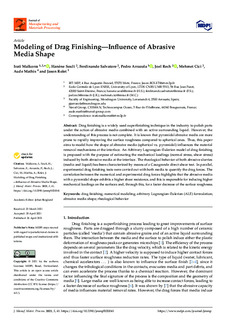| dc.rights.license | Attribution 4.0 International | * |
| dc.contributor.author | ARRAZOLA, PEDRO JOSE | |
| dc.contributor.other | Malkorra Sarasola, Irati | |
| dc.contributor.other | Hanène, Souli | |
| dc.contributor.other | Salvatore, Ferdinando | |
| dc.contributor.other | Rech, Joël | |
| dc.contributor.other | Cici, Mehmet | |
| dc.contributor.other | Mathis, Aude | |
| dc.contributor.other | Rolet, Jason | |
| dc.date.accessioned | 2021-04-26T11:08:44Z | |
| dc.date.available | 2021-04-26T11:08:44Z | |
| dc.date.issued | 2021 | |
| dc.identifier.issn | 2504-4494 | en |
| dc.identifier.other | https://katalogoa.mondragon.edu/janium-bin/janium_login_opac.pl?find&ficha_no=163342 | en |
| dc.identifier.uri | https://hdl.handle.net/20.500.11984/5280 | |
| dc.description.abstract | Drag finishing is a widely used superfinishing technique in the industry to polish parts under the action of abrasive media combined with an active surrounding liquid. However, the understanding of this process is not complete. It is known that pyramidal abrasive media are more prone to rapidly improving the surface roughness compared to spherical ones. Thus, this paper aims to model how the shape of abrasive media (spherical vs. pyramidal) influences the material removal mechanisms at the interface. An Arbitrary Lagrangian–Eulerian model of drag finishing is proposed with the purpose of estimating the mechanical loadings (normal stress, shear stress) induced by both abrasive media at the interface. The rheological behavior of both abrasive slurries (media and liquid) has been characterized by means of a Casagrande direct shear test. In parallel, experimental drag finishing tests were carried out with both media to quantify the drag forces. The correlation between the numerical and experimental drag forces highlights that the abrasive media with a pyramidal shape exhibits a higher shear resistance, and this is responsible for inducing higher mechanical loadings on the surfaces and, through this, for a faster decrease of the surface roughness. | en |
| dc.language.iso | eng | en |
| dc.publisher | MDPI | en |
| dc.rights | © 2021 by the authors. Licensee MDPI | en |
| dc.rights.uri | http://creativecommons.org/licenses/by/4.0/ | * |
| dc.subject | drag finishing | en |
| dc.subject | numerical modelling | en |
| dc.subject | arbitrary Lagrangian–Eulerian (ALE) formulation | en |
| dc.subject | abrasive media shape | en |
| dc.subject | rheological behavior | en |
| dc.title | Modeling of Drag Finishing: Influence of Abrasive Media Shape | en |
| dc.type | http://purl.org/coar/resource_type/c_6501 | |
| dcterms.accessRights | http://purl.org/coar/access_right/c_abf2 | en |
| dcterms.source | Journal of Manufacturing and Materials Processing | en |
| local.contributor.group | Mecanizado de alto rendimiento | es |
| local.description.peerreviewed | true | en |
| local.identifier.doi | https://doi.org/10.3390/jmmp5020041 | en |
| local.rights.publicationfee | APC | en |
| local.embargo.enddate | 2021 | |
| local.contributor.otherinstitution | https://ror.org/017cfeh02 | es |
| local.contributor.otherinstitution | https://ror.org/0199zgv94 | es |
| local.contributor.otherinstitution | Naval Group CESMAN | es |
| local.source.details | (Special Issue Surface Integrity in Machining and Post-processing). Vol. 5. N. 2. N. artículo 41, 2021 | en |
| oaire.format.mimetype | application/pdf | |
| oaire.file | $DSPACE\assetstore | |
| oaire.resourceType | http://purl.org/coar/resource_type/c_6501 | en |
| oaire.version | http://purl.org/coar/version/c_970fb48d4fbd8a85 | en |








